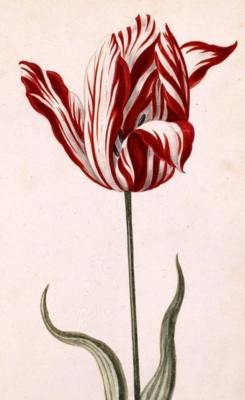
Although still one of the world’s favourite flowers, when it was introduced into Europe 400 years ago the tulip caused ‘tulipmania’. Rare bulbs were worth as much as a house, particularly in Holland.
The expanding interest in tulips coincided with an especially prosperous period in the history of the United Provinces, which, by the 17th Century, dominated world trade and had become the richest country in Europe. As a result, not only aristocratic citizens but also wealthy merchants and even middle-class artisans and tradesmen suddenly found that they had spare cash to spend on luxuries such as expensive flowers.
Already by 1623, the sum of 12,000 guilders – considerably more than the value of a smart townhouse in Amsterdam – was offered to tempt one tulip connoisseur into parting with only 10 bulbs of the beautiful, and extremely rare, Semper Augustus – the most coveted tulip variety. It was not enough to secure a deal.
When word got out, during the 1630s, that tulip bulbs were being sold for ever-increasing prices, more and more speculators piled in to the market. The intricacies of this market, as well as its frailties, are brilliantly outlined by the historian Mike Dash in Tulipomania: The Story of the World’s Most Coveted Flower and the Extraordinary Passions It Aroused (1999).
One of the curiosities of the 17th Century tulip market was that people did not trade the flowers themselves but rather the bulbs of scarce and sought-after varieties. The result, as Dash points out, was “what would today be called a futures market”. Tulips even began to be used as a form of money in their own right: in 1633, actual properties were sold for handfuls of bulbs.
As people heard stories of acquaintances making unheard-of profits simply by buying and selling tulip bulbs, they decided to get in on the act – and prices skyrocketed. In 1633, a single bulb of Semper Augustus was already worth an astonishing 5,500 guilders. By the first month of 1637, this had almost doubled, to 10,000 guilders. Dash puts this sum in context: “It was enough to feed, clothe and house a whole Dutch family for half a lifetime, or sufficient to purchase one of the grandest homes on the most fashionable canal in Amsterdam for cash, complete with a coach house and an 80-ft (25-m) garden – and this at a time when homes in that city were as expensive as property anywhere in the world.”
Credit : Culture
Picture Credit : Google




